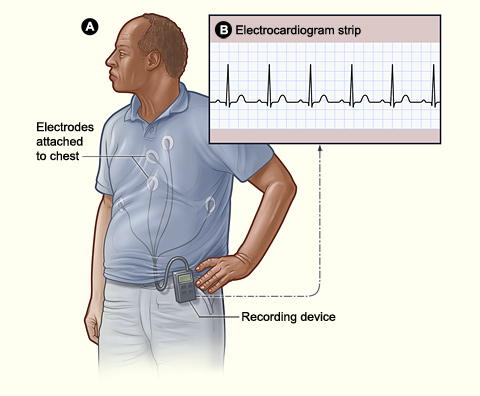How Are Palpitations Diagnosed?
Your doctor will first want to find out whether your
palpitations are harmless or related to a more serious heart problem. To do
this, he or she will ask about your symptoms and medical history, do a physical
exam, and order several basic tests.
This information may point to a heart problem as the
cause for your palpitations. If so, your doctor may recommend more tests. These
will help show what the problem is and how to treat it.
The cause of palpitations may be hard to diagnose,
especially if symptoms don’t occur regularly.
Specialists Involved
Several types of doctors may work with you to
diagnose and treat your palpitations. These include a:
- Primary care doctor
- Cardiologist (a doctor who specializes in
treating adults who have heart problems)
- Electrophysiologist (e-LEK-tro-fiz-e-OL-o-jist; a
cardiologist who specializes in the heart’s electrical system)
Medical History
Your doctor will ask questions about your
palpitations, such as:
- When did they begin?
- How long do they last?
- How often do they occur?
- Do they start and stop suddenly?
- Does your heartbeat feel steady or irregular
during the palpitations?
- What other symptoms do you have when you get
palpitations? (See “What Are the Signs and
Symptoms of Palpitations?”)
- Do your palpitations have a pattern? For example,
do they occur when you exercise or drink coffee? Do they happen at a certain
time of day?
Your doctor also will ask you about your use of
caffeine, alcohol, supplements, and illegal drugs.
Physical Exam
Your doctor will take your pulse to find out how
fast your heart is beating and whether it’s beating with a normal rhythm.
He or she also will use a stethoscope to listen to your heartbeat.
Your doctor also may look for signs of other
conditions (such as an overactive thyroid) that can cause palpitations.
Diagnostic Tests
Often, the first test that’s done is an
EKG
(electrocardiogram). This simple test records your heart’s electrical
activity. An EKG is used to detect and locate the source of heart problems. It
shows how fast your heart is beating and whether its rhythm is steady or
irregular. It records the strength and timing of electrical signals as they
pass through each part of your heart.
Even if your EKG results are normal, you may still
have a medical condition that’s causing palpitations. If your doctor
suspects this is the case, he or she will order blood tests to gather more
information about your heart’s structure, function, and electrical
system.
Holter Monitor
A
Holter
monitor records the electrical signals of your heart for a full 24- or
48-hour period. You wear small patches called electrodes on your chest. Wires
connect the patches to a small, portable recorder. The recorder can be clipped
to a belt, kept in a pocket, or hung around your neck.
Holter or Event Monitor

Figure A shows how a Holter or event
monitor attaches to a patient. In this example, the monitor is clipped to the
patient’s belt and electrodes are attached to his chest. Figure B shows an
electrocardiogram strip, which maps the data from the Holter or event
monitor.
During the 24- or 48-hour period, you do your usual
daily activities. You keep a notebook and note any symptoms you have and the
time they occur. You then return both the recorder and the notebook to your
doctor to read the results. Your doctor can see how your heart was beating at
the time you had symptoms.
Event Monitor
An event monitor is similar to a Holter monitor. You
wear an event monitor while doing your normal activities. However, an event
monitor only records your heart’s electrical activity at certain times
while you’re wearing it.
For many event monitors, you push a button to start
the monitor when you feel symptoms. Other event monitors start automatically
when they sense abnormal heart rhythms.
Event monitors can be worn for 1 to 2 months, or as
long as it takes to record your heart’s activity during palpitations.
Echocardiography
Echocardiography
uses sound waves to create a moving picture of your heart. The picture shows
the size and shape of your heart. It also shows your heart valves and how well
they're working.
Stress Test
Some heart problems are easier to diagnose when your
heart is working harder and beating faster than when it's at rest. During
stress
testing, you exercise (or are given medicine if you're unable to exercise)
to make your heart work hard and beat fast while heart tests are done.
|

